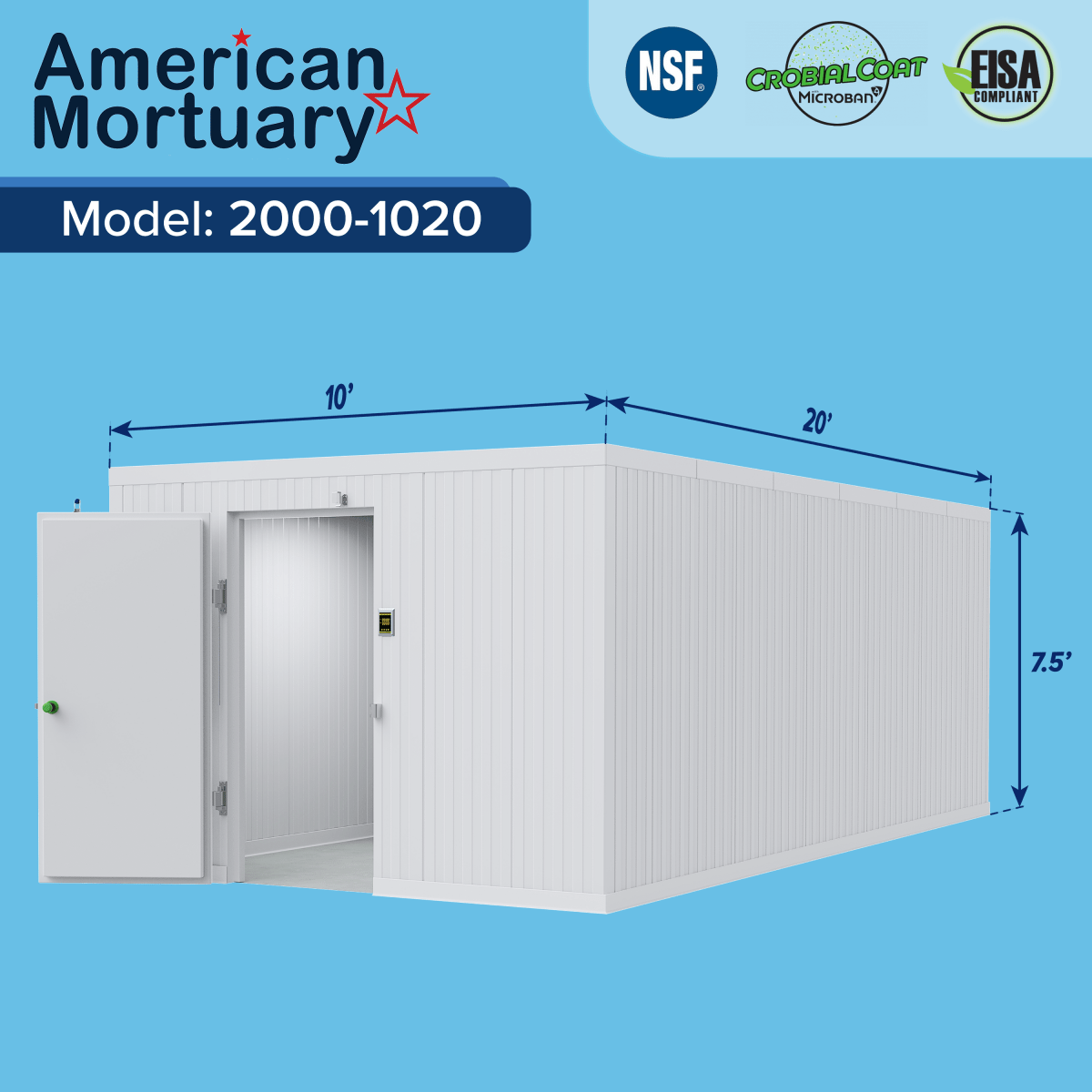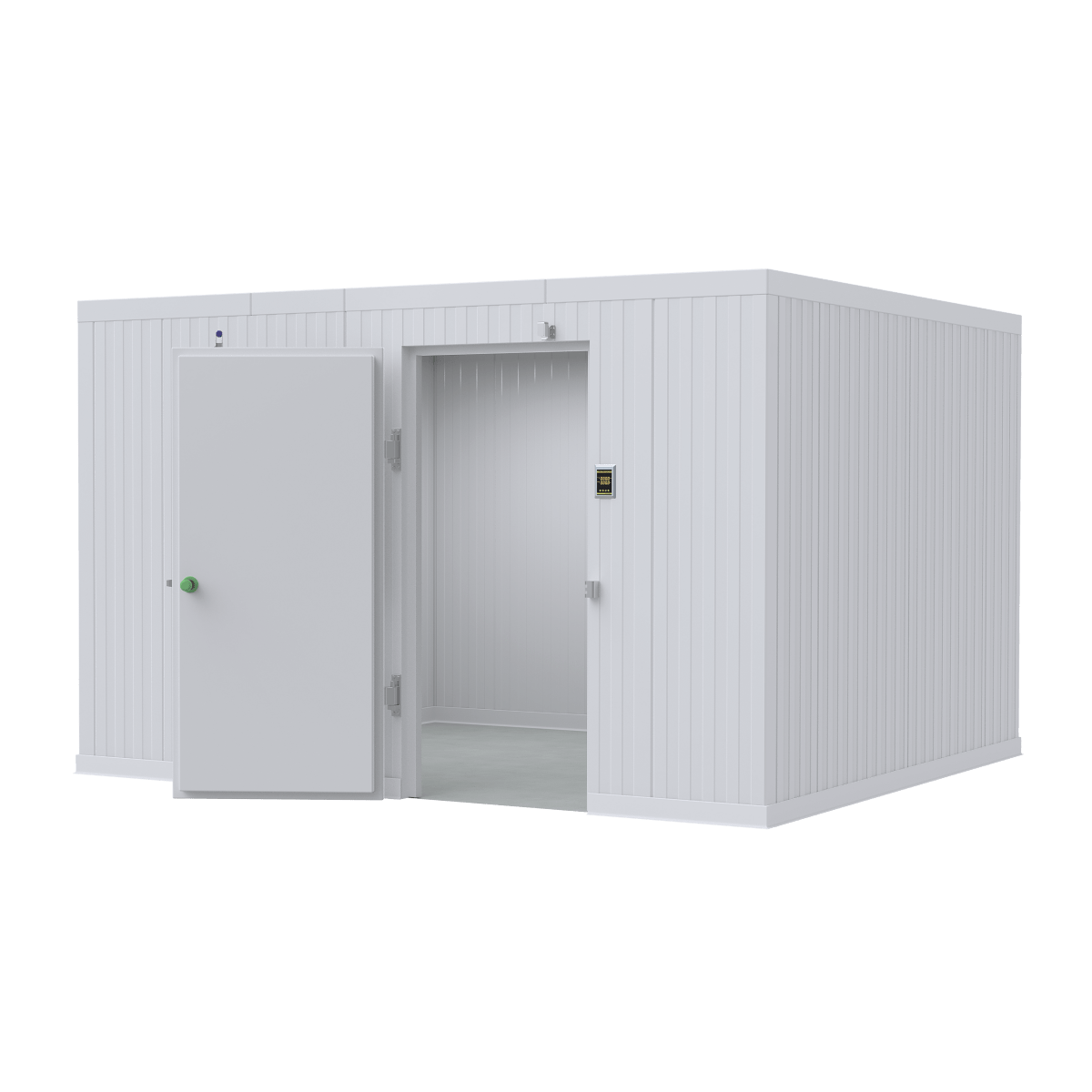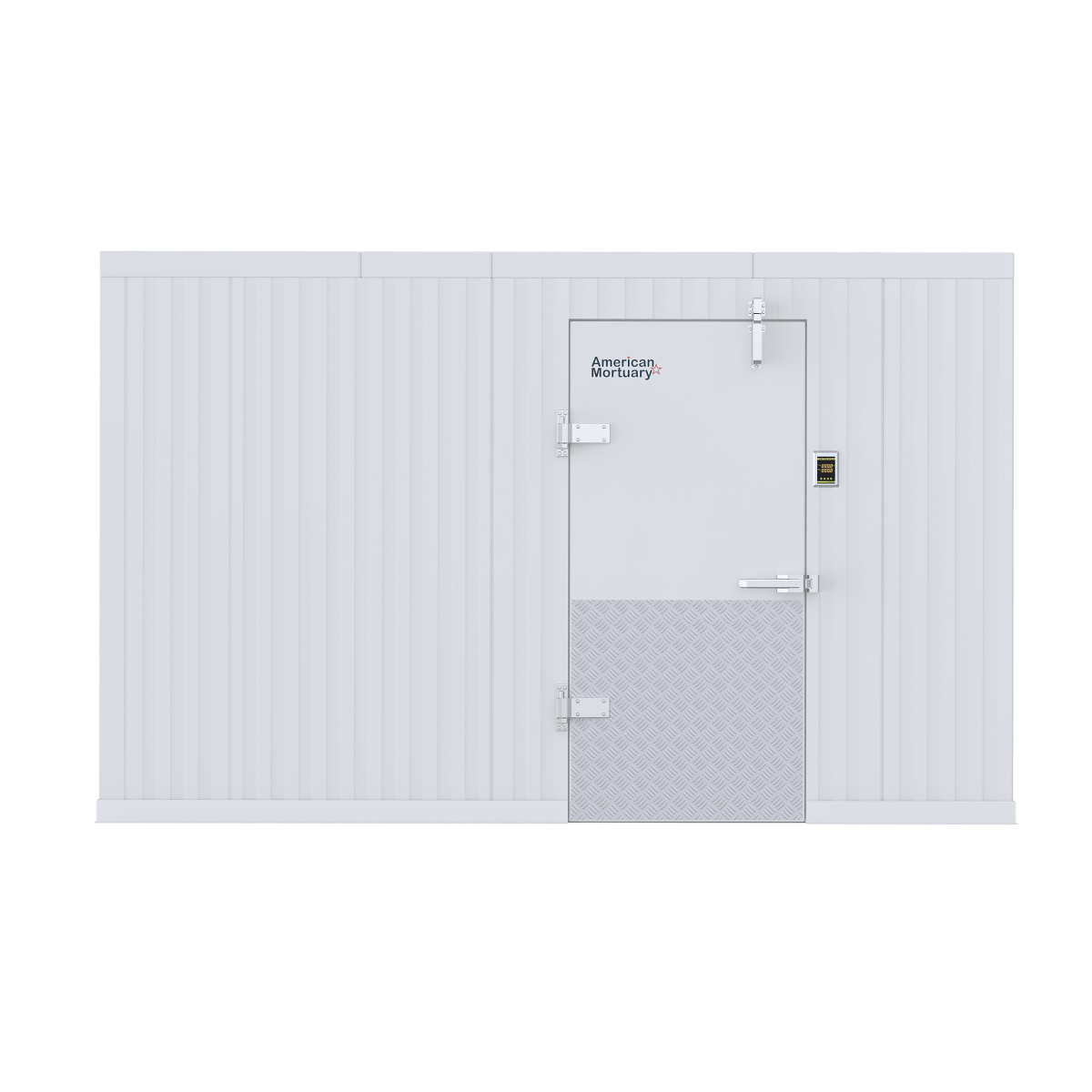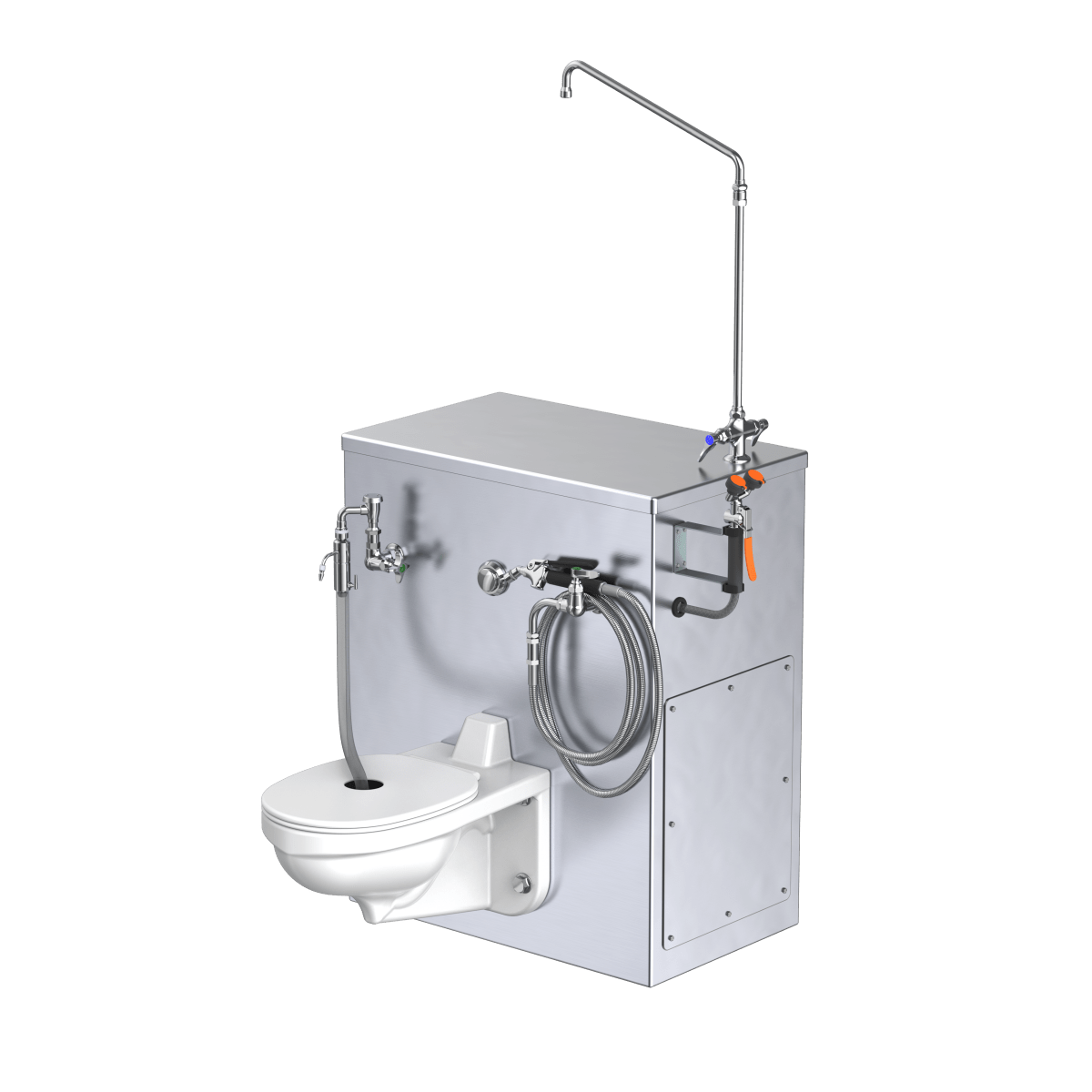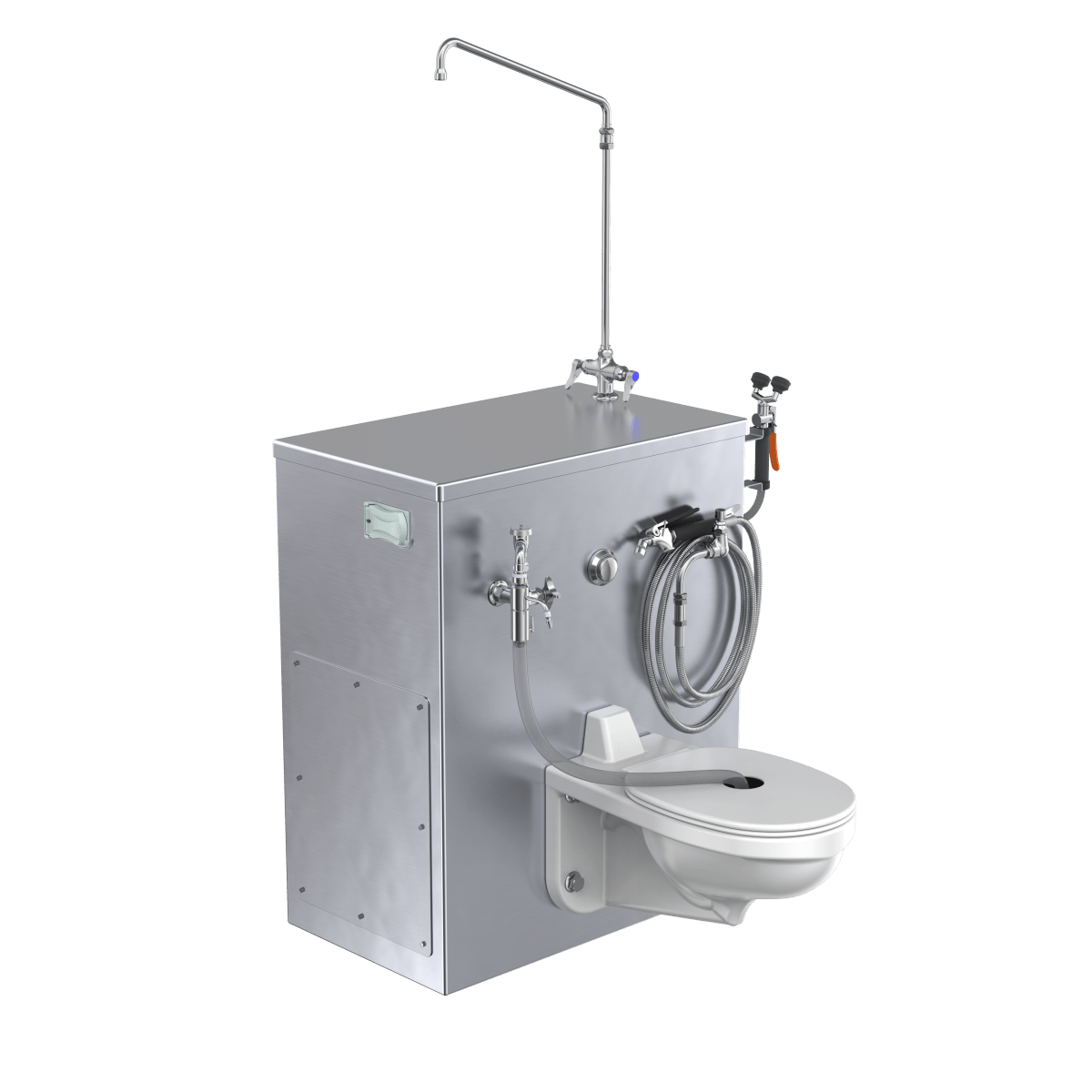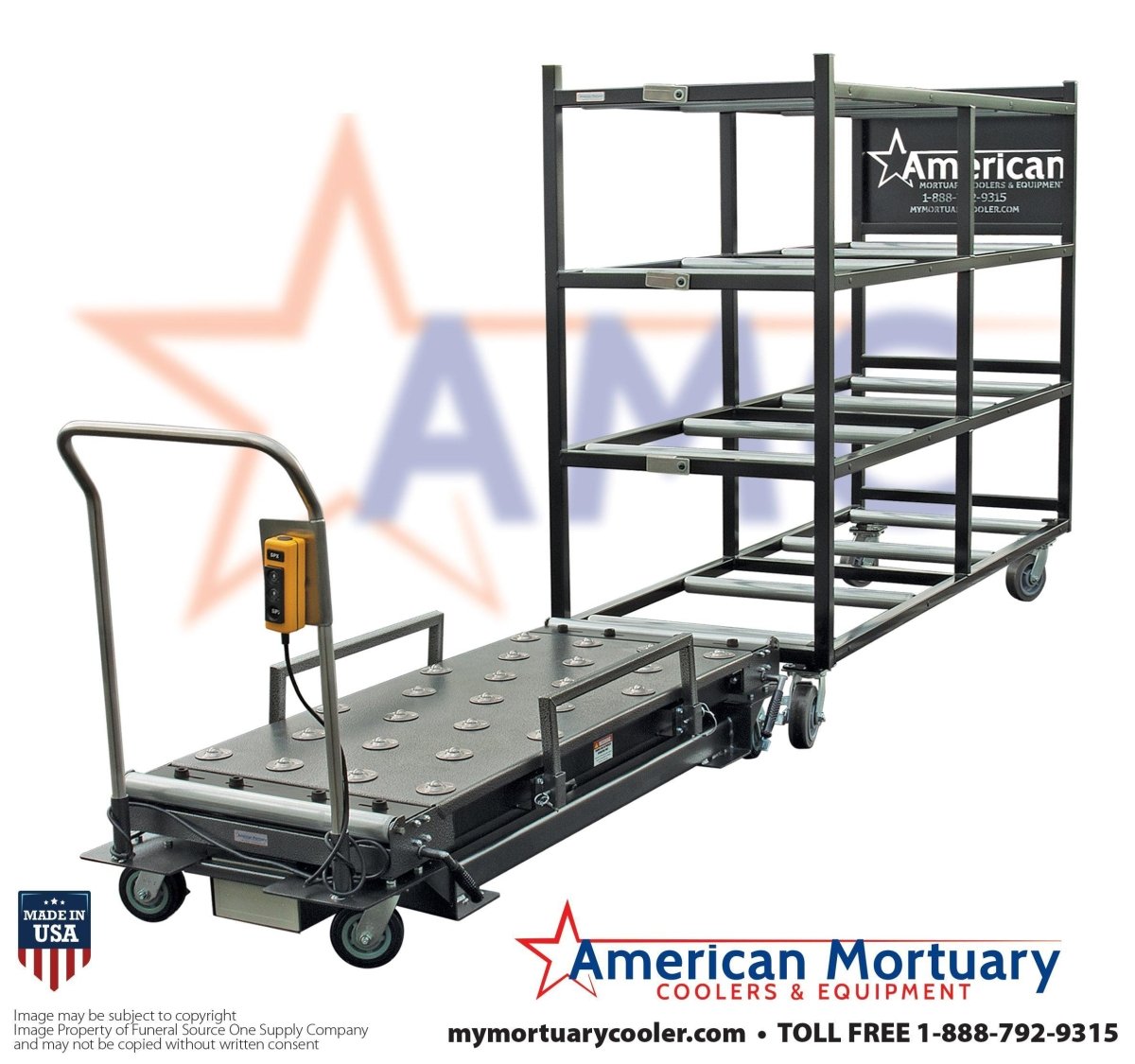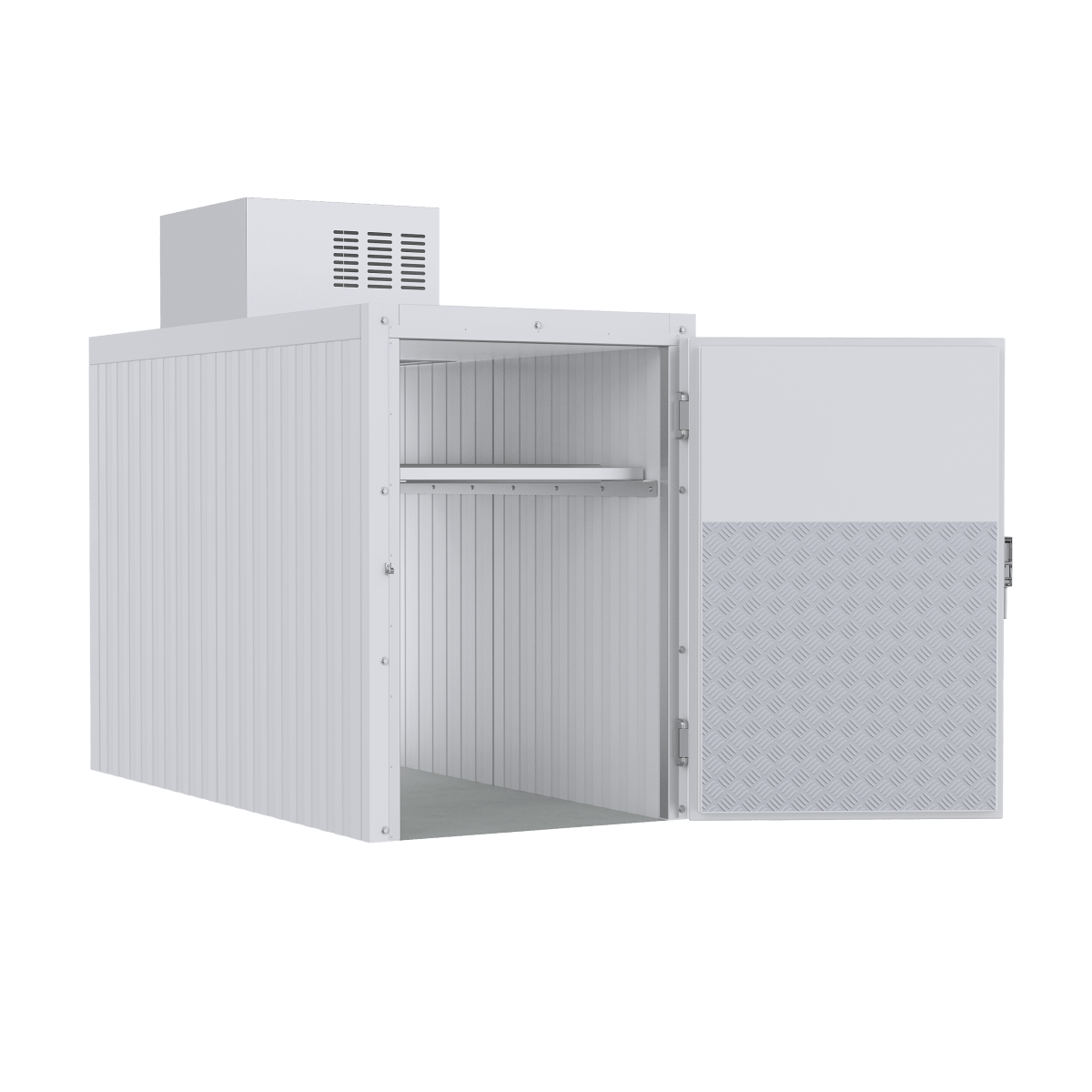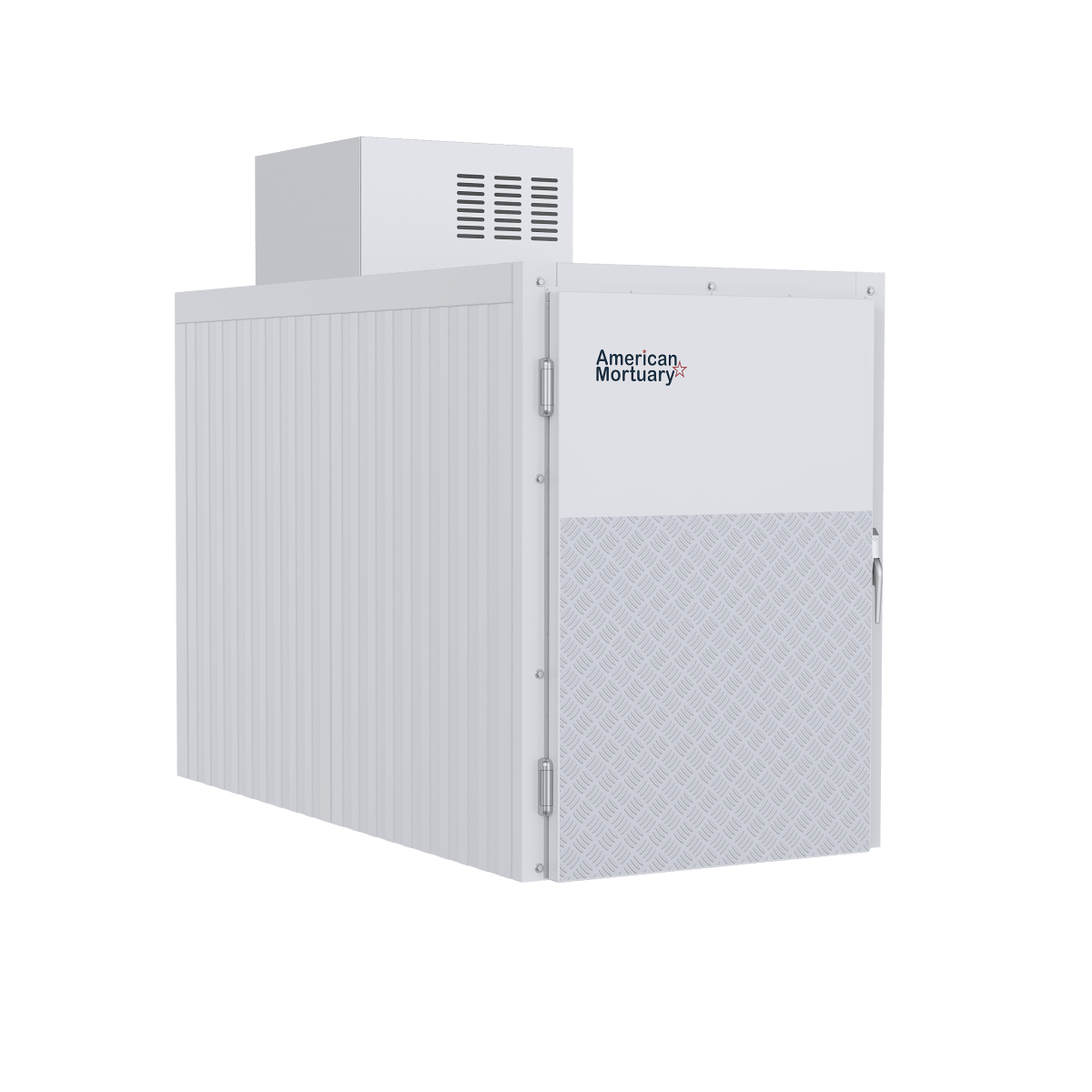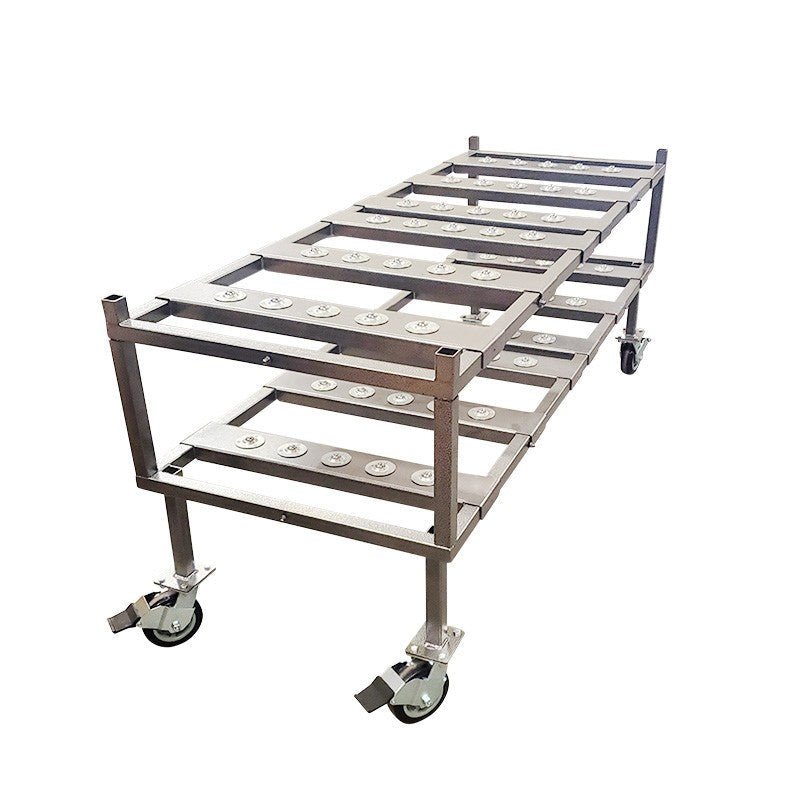Why Natural Organic Reduction is Changing End-of-Life Care
Natural organic reduction is changing how we think about death care by turning human remains into nutrient-rich soil through accelerated composting. This eco-friendly alternative to burial and cremation takes 30-60 days and produces about one cubic yard of compost per body.
Quick Facts About Natural Organic Reduction:
- Process: Body + organic materials → soil in 4-6 weeks
- Cost: $3,000-$7,000 (vs. $7,848 median burial)
- Legal Status: Available in 11 U.S. states as of 2024
- Environmental Impact: Saves 1 metric ton of CO₂ per person
- Output: ~200 pounds of nutrient-rich soil per body
The numbers tell a compelling story. Traditional cremation releases 418 pounds of CO₂ into the atmosphere - equivalent to driving 470 miles. Multiply that by the 1.74 billion pounds of CO₂ from U.S. cremations annually, and you see why funeral directors are exploring greener options.
"Throw me in the woods, let me decompose, and I'll just be plant food," says every aunt and uncle who wants to be shocking and humorous, but what if that idea is not so far-fetched? Natural organic reduction makes this vision reality through controlled, accelerated decomposition that transforms human remains into fertile soil.
As American Mortuary Coolers with years of experience helping funeral homes adapt to changing consumer demands, we've seen how natural organic reduction is reshaping our industry's approach to sustainable death care. Our expertise in mortuary equipment has shown us how facilities are preparing for this growing trend.
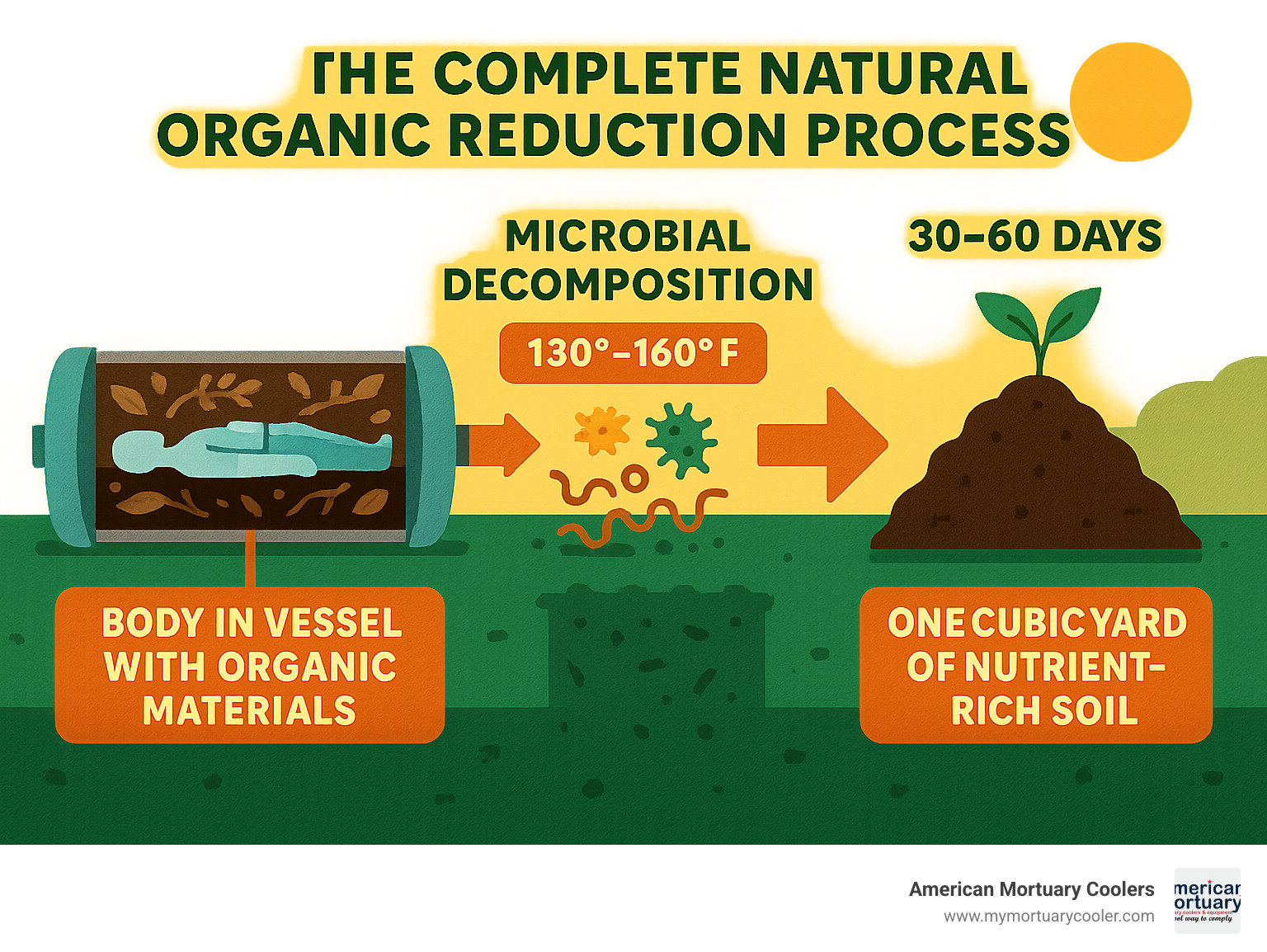
Related content about natural organic reduction:
Natural Organic Reduction 101: Definition, History & How It Works
Natural organic reduction (NOR) might sound like complicated science, but it's actually quite simple. Also called human composting or terramation, this process does what nature has always done—it just speeds things up a bit.
Think about it: farmers have been composting livestock safely for decades. When avian flu hit in 2022 and millions of chickens needed disposal, composting proved it could handle large-scale biological materials without any issues. That same proven science now helps families choose a gentler path for their loved ones.
The beauty of natural organic reduction lies in working with nature instead of against it. Rather than burning bodies at 1,800°F or preserving them indefinitely in concrete vaults, NOR lets natural processes do what they do best.
More info about turning a body into compost
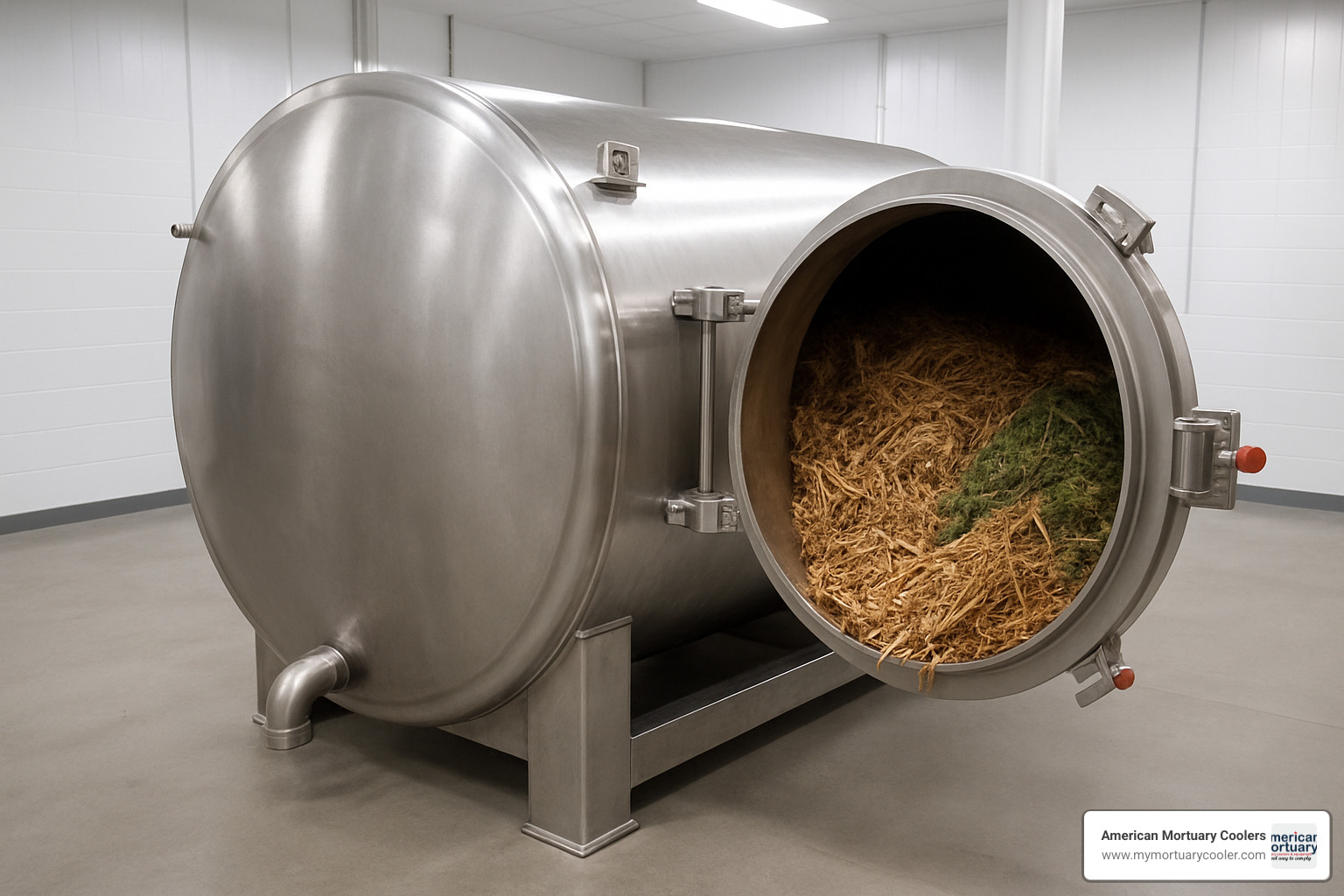
What is Natural Organic Reduction?
Natural organic reduction is officially defined as "the contained, accelerated conversion of human remains to soil." But that clinical definition doesn't capture the neat simplicity of what's actually happening.
Picture a specially designed vessel where a body rests surrounded by wood chips, straw, and alfalfa. These organic materials create the perfect home for tiny microbes that are already present everywhere in nature. These thermophilic microbes get to work immediately, generating heat between 130°F and 160°F as they break down organic matter.
This isn't random decomposition—it's accelerated composting in a contained vessel where every variable is carefully controlled. The temperature naturally sterilizes everything while the microbes transform human remains into rich, fertile soil over the course of about two months.
Pioneers & Milestones
The story of modern human composting begins with Katrina Spade, an architecture graduate student who learned about livestock composting and wondered: "Why not humans too?" Her question sparked a movement that would eventually create an entirely new option for end-of-life care.
Spade founded Recompose with a mission to make death care more sustainable. After years of research, lobbying, and facility development, her vision became reality when Washington state legalized the practice in 2019.
The milestones came quickly after that breakthrough. Washington legalization opened the floodgates, followed by Recompose opening as the first commercial facility in 2020. Herland Forest earned the first license that same year, while Return Home and other facilities soon joined the movement.
By 2024, the timeline shows remarkable growth: eleven states have legalized human composting, with more considering legislation every year. Since opening, Recompose alone has composted over 200 bodies and has more than 1,100 people signed up for future services.
Step-by-Step Overview of the NOR Process
The natural organic reduction process unfolds in two distinct phases, each serving a crucial purpose in creating safe, nutrient-rich soil.
The Active Phase (Weeks 1-4)
Everything starts with a biodegradable shroud—usually pure cotton or another natural fiber. The body is gently placed in the vessel along with a carefully measured wood chips, alfalfa, and straw mix. This isn't random; each material serves a specific purpose in feeding the thermophilic microbes that drive the process.
Within days, the temperature reaches 130-160°F as billions of microbes begin their work. This heat does double duty—it accelerates decomposition while killing any harmful pathogens. The vessel contents are periodically turned to ensure proper airflow and even breakdown throughout.
The Finishing Phase (Weeks 5-8)
After the initial month, any remaining bones go through bone refinement using equipment similar to what's used in cremation. The processed bone material returns to the compost mixture for the curing phase, where everything stabilizes over another 2-6 weeks.
Final screening removes any non-organic materials that somehow made it through. The result? Approximately one cubic yard of soil output—about 200 pounds of rich, fertile compost that families can use to nourish new life.
Custom HVAC systems with biofilters manage airflow throughout the entire process, ensuring microbial decomposition happens efficiently without any odor issues for neighboring areas.
Environmental, Economic & Safety Impact
When families choose natural organic reduction, they're making a decision that ripples far beyond their personal grief. The environmental math is compelling: while cremation pumps 418 pounds of CO₂ into the atmosphere per body, NOR actually helps heal the planet.
Think about it this way - every cremation produces emissions equivalent to driving from Nashville to Atlanta. With over 1.7 million cremations happening annually in the U.S., that's a lot of unnecessary carbon floating around. Natural organic reduction flips this equation entirely.
Scientific research on pathogen reduction
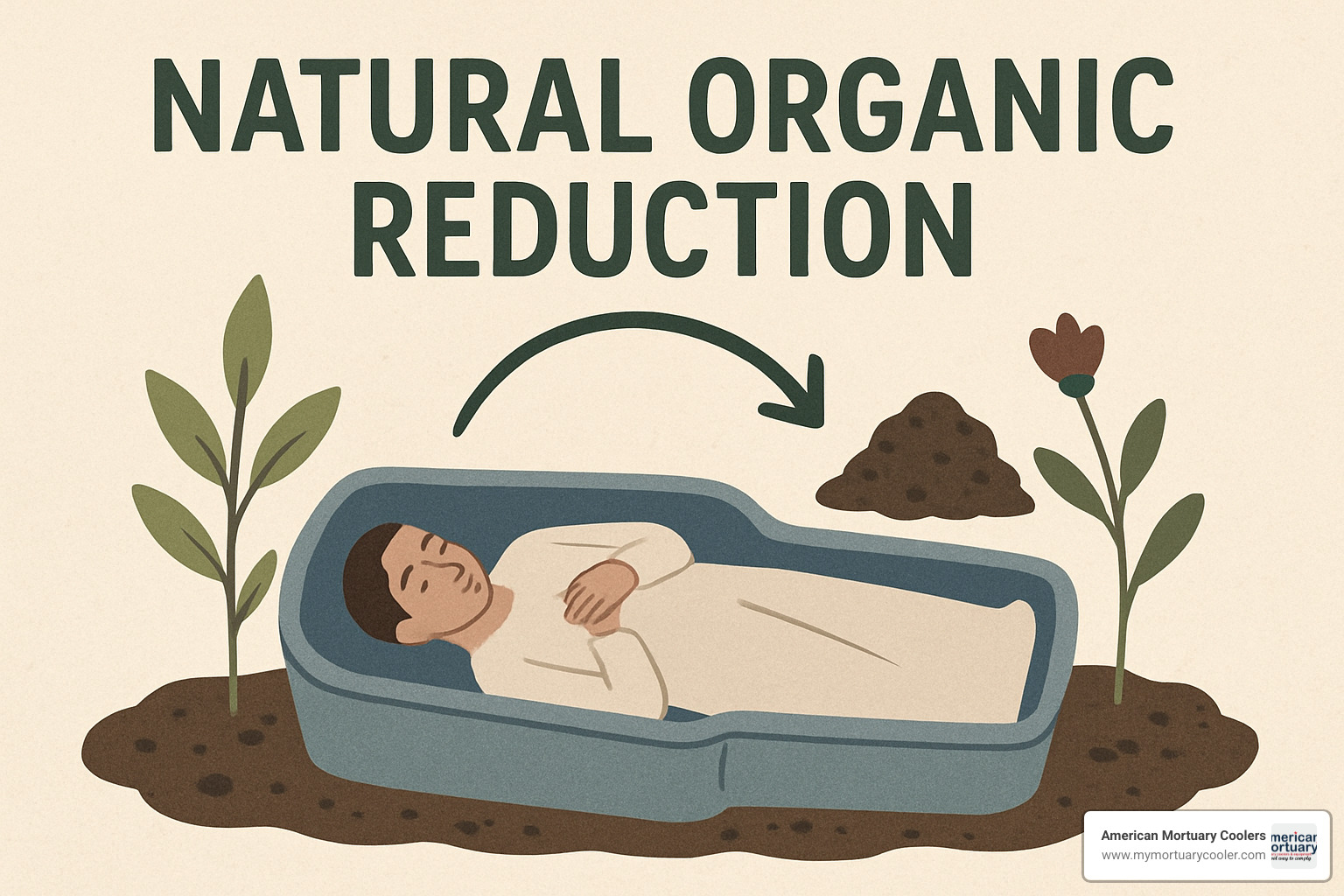
Benefits for Climate & Soil
Natural organic reduction saves approximately one metric ton of carbon from entering the atmosphere compared to conventional death care options. That's not just avoiding emissions - it's actually removing carbon from the air through soil sequestration.
The magic happens in the soil itself. When families use their loved one's compost in memorial gardens or donate it to conservation projects, that soil becomes a carbon sponge. Healthy soil stores atmospheric carbon for decades, turning every NOR choice into a lasting environmental gift.
The soil regeneration benefits go way beyond carbon storage. This isn't just dirt - it's premium compost that transforms degraded land into thriving ecosystems. The nutrient-rich soil improves water retention, supports beneficial microbes, and provides essential nutrients that help plants flourish.
Many families find deep meaning in knowing their loved one continues nurturing life. Memorial forests planted with NOR soil create living legacies that grow stronger each year, sequestering more carbon while providing habitat for wildlife.
Potential Risks & How Facilities Mitigate Them
Let's address the elephant in the room - safety concerns. When people first hear about human composting, questions naturally arise about disease control, contamination, and whether the process is truly safe.
The good news? Natural organic reduction facilities have developed robust safeguards that exceed traditional funeral industry standards.
Disease control starts with careful screening. Bodies with certain conditions like Ebola, active tuberculosis, or prion diseases are excluded from the process. For everyone else, the temperature monitoring systems ensure internal vessel temperatures stay between 130°F and 160°F - hot enough to kill bacteria, viruses, and parasites while maintaining optimal composting conditions.
Heavy metal management actually works better in NOR than cremation. While cremation volatilizes mercury from dental fillings and sends it airborne, natural organic reduction stabilizes heavy metals in the soil matrix. Regular testing ensures the final compost meets strict EPA limits for arsenic, cadmium, copper, zinc, lead, and mercury.
Pharmaceutical breakdown happens naturally during the composting process. Most medications are already metabolized or excreted before death, and the NOR process achieves 95% reduction in any remaining pharmaceutical compounds. What's left falls well below harmful levels.
Odor control relies on proper microbial activity rather than masking chemicals. When the composting process works correctly, microbes break down odorous compounds into simple water and CO₂. Modern facilities use biofilters and mechanical ventilation to ensure no unpleasant smells escape the building - neighbors shouldn't even know the facility exists.
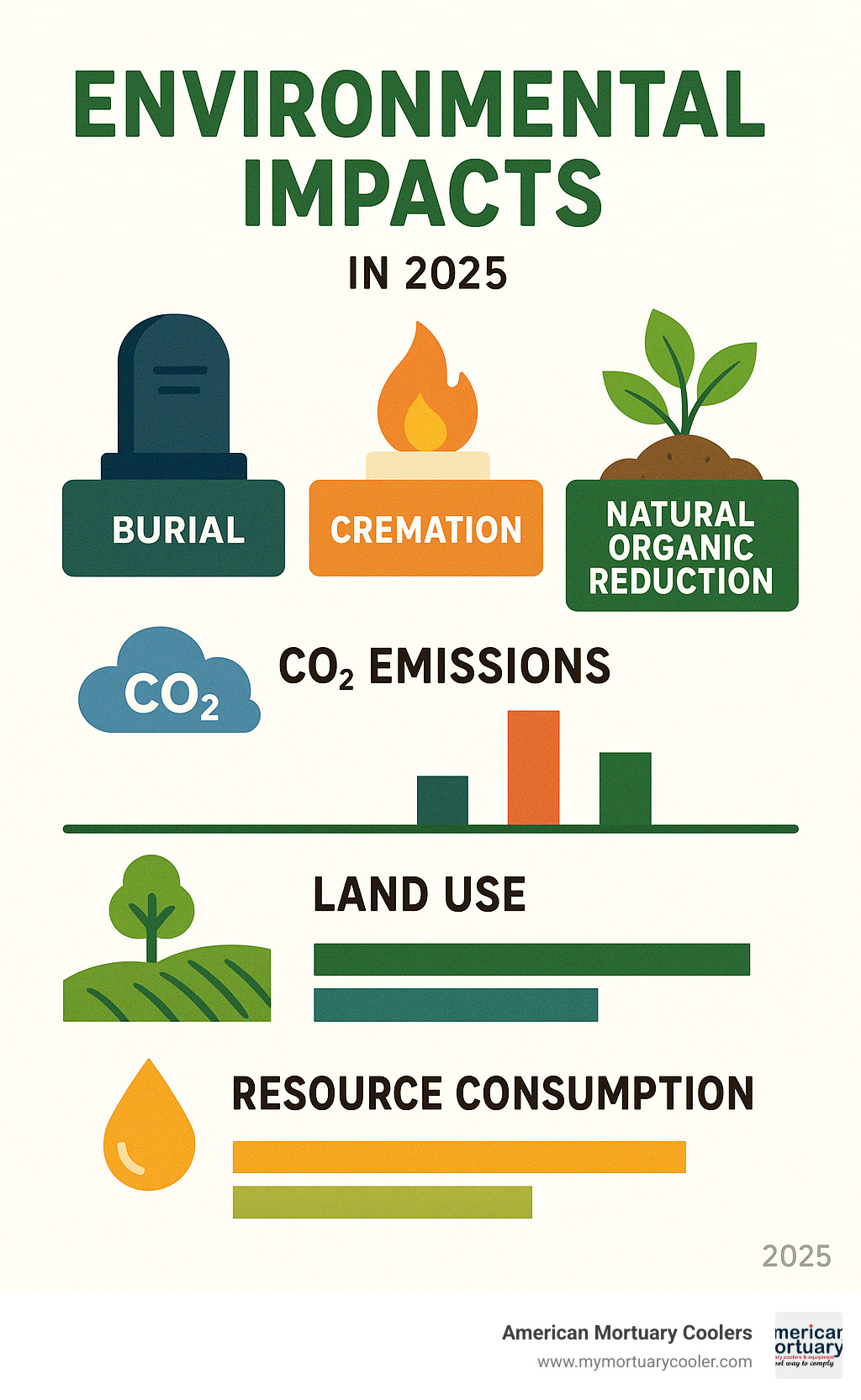
Legal Status, Costs & How to Arrange NOR
The landscape of natural organic reduction legality is expanding rapidly across America. What started as a single-state experiment in Washington has grown into a movement spanning eleven states, with more legislation pending each year.
As of 2024, you can legally choose natural organic reduction in Washington, Colorado, Oregon, Vermont, California, New York, Nevada, Arizona, Maryland, Delaware, and Minnesota. Each state crafted its own regulations, but the core process remains consistent.
More info about states allowing body composting
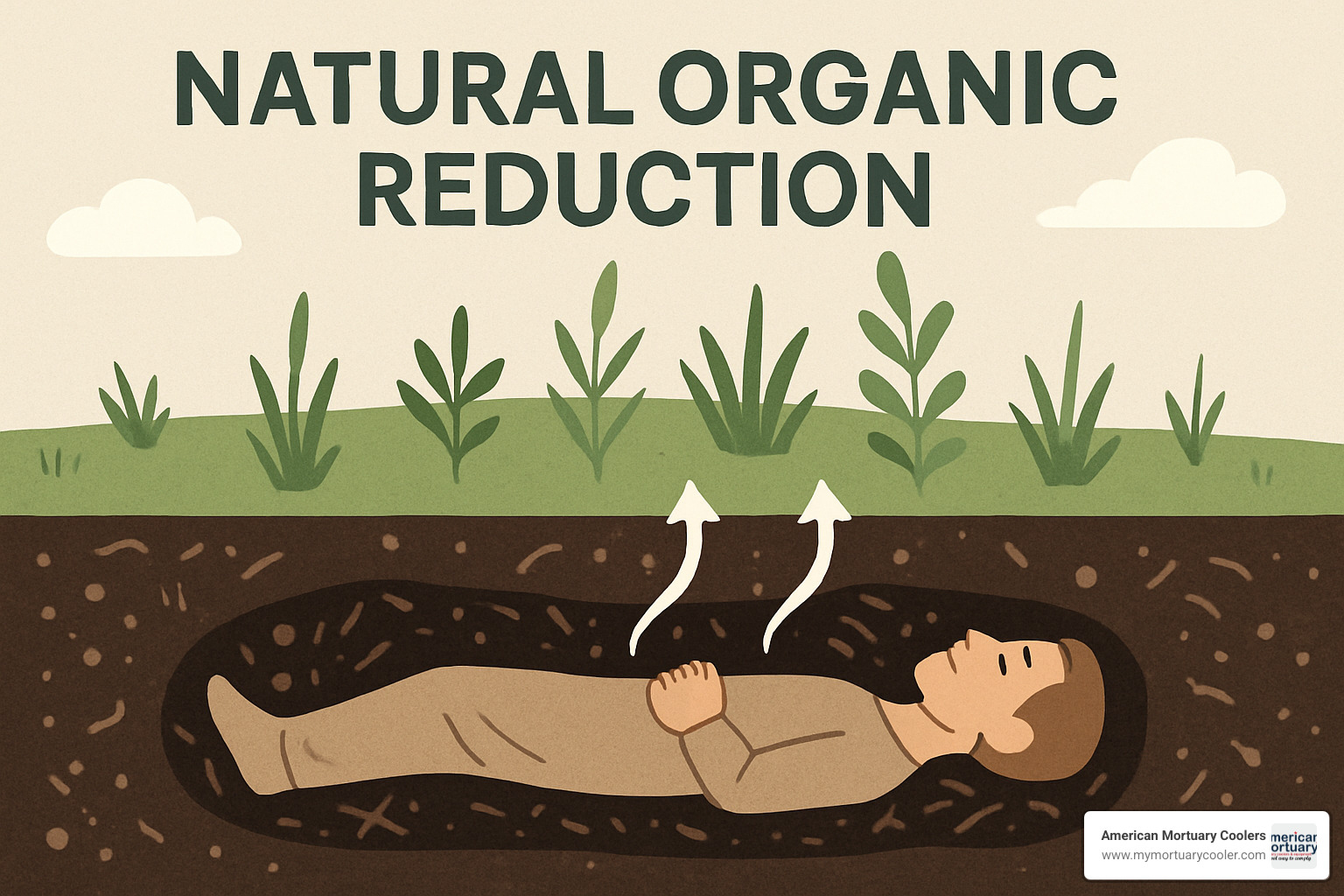
Washington blazed the trail in 2020, with multiple facilities now operating smoothly. Colorado and Oregon followed in 2021-2022, proving the concept works across different climates and regulations. Vermont joined in 2023, while California will begin offering services in 2027.
The newer states show interesting patterns. Nevada legalized the practice in 2024, while Arizona, Maryland, and Delaware recently passed their own legislation. Minnesota takes a measured approach, with their law taking effect July 1, 2025.
New York presents an interesting case - they've legalized NOR but are still working out implementation rules. This careful approach helps ensure facilities meet all safety and environmental standards before opening.
Cost Comparison & Payment Options
Money talk can be uncomfortable when planning end-of-life care, but natural organic reduction offers surprising value. At $3,000-$7,000, it costs less than traditional burial while delivering environmental benefits that last generations.
Traditional burial averages $7,848 nationwide, while cremation with services runs about $6,971. Direct cremation offers the lowest cost at under $2,000, but lacks the environmental benefits of NOR. Green burial costs $1,000-$2,000 but requires specific cemetery locations that aren't available everywhere.
The price range for natural organic reduction depends on several factors. Geographic location plays a big role - facilities in major metropolitan areas typically charge more than rural operations. Service packages vary widely, from basic disposition to full memorial services with grief support.
Transportation requirements can add significant costs, especially for out-of-state residents. However, many facilities work with transport coordinators to minimize these expenses. Pre-need arrangements often cost less than at-need services, giving you both peace of mind and financial savings.
Payment options have evolved as the industry matures. Many facilities now offer pre-need payment plans that spread costs over time. Some providers offer financing options - one facility allows three payments of $995 each. Most accept life insurance assignments, and several offer low-income assistance programs for qualifying families.
How to Start the Process
Planning for natural organic reduction doesn't have to feel overwhelming. Whether you're pre-planning or facing an immediate need, the process follows logical steps that funeral professionals handle every day.
Pre-planning gives you the most options and often the best prices. Start by contacting a licensed NOR facility in a legal state. They'll walk you through their specific process and pricing. Complete the pre-arrangement paperwork at your own pace, and set up payment arrangements that work for your budget.
Don't forget to inform your family about your choice. Include your NOR preference in estate planning documents, and make sure your designated decision-maker knows how to contact your chosen facility.
Immediate need situations move faster but follow similar steps. Contact a funeral director experienced with natural organic reduction - they understand the unique requirements and can coordinate everything for you. If you live outside a legal state, they'll arrange proper transportation while keeping costs reasonable.
Interstate transport requires specific expertise since bodies must remain unembalmed for NOR. Licensed funeral directors handle all the paperwork, permits, and logistics. Transport coordinators specialize in these arrangements and can often reduce costs through established networks.
The required paperwork mirrors traditional disposition methods - you'll need proper death certificates and disposition authorization forms. Licensed facilities guide families through each requirement, ensuring nothing gets missed during an already difficult time.
Natural organic reduction facilities often have scheduling considerations due to limited vessel capacity. Pre-arrangements help secure your preferred timing, while immediate needs receive priority scheduling to accommodate families.
Cultural, Ethical & Family Perspectives
Natural organic reduction touches the heart of how we view death, spirituality, and our connection to the earth. These deeply personal considerations shape family decisions and reflect changing attitudes about end-of-life care.
Religious perspectives on human composting vary widely. The Catholic Church has expressed concerns about the practice, preferring traditional burial or cremation. Jewish traditions generally emphasize returning the body to earth intact, though some progressive communities are exploring NOR as fulfilling the principle of returning "dust to dust." Muslim teachings typically require burial without cremation, but scholars continue debating whether composting aligns with Islamic principles of honoring the deceased.
Many families find comfort in land-return rituals that celebrate the cycle of life. Memorial services often include planting ceremonies where loved ones use the resulting soil to nurture trees or create remembrance gardens. These living memorials provide ongoing connection and healing that traditional headstones cannot offer.
Grief support becomes especially important when choosing non-traditional options. Families sometimes worry about explaining their choice to others or managing reactions from extended family members. Most NOR facilities provide counseling resources and help families steer these conversations with sensitivity and understanding.
More info about human composting options
Why Choose Natural Organic Reduction?
People choose natural organic reduction because it aligns with their deepest values about life, death, and legacy. Environmental consciousness drives many decisions - folks who spent their lives recycling, composting kitchen scraps, and reducing their carbon footprint want their final act to reflect those same principles.
The eco legacy aspect resonates powerfully. Instead of taking up cemetery space forever or releasing emissions through cremation, NOR creates something beneficial. Families often describe feeling good about "giving back to the earth" rather than just taking from it.
Urban space saving matters too, especially in cities where cemetery plots cost thousands of dollars and land is precious. One cubic yard of soil takes up far less space than a traditional grave, and it can be used anywhere - from backyard memorial gardens to conservation land restoration projects.
Personal values around natural cycles influence many choices. Some people simply feel more comfortable with the idea of decomposing naturally rather than being preserved with chemicals or reduced to ash. The process feels more organic and connected to how nature handles death.
Cost considerations play a role as well. At $3,000-$7,000, NOR often costs less than traditional burial while providing environmental benefits that cremation cannot match.
Handling Non-Organic Materials & Medical Implants
Modern medicine means most bodies contain materials that don't compost naturally. Pacemakers and defibrillators must be removed before the process begins - these devices can explode if heated and pose safety risks. Licensed funeral directors handle this removal as part of their standard procedures.
Joint replacements like hip and knee prosthetics, along with surgical screws, plates, and pins, get separated during the final screening process. These metal implants don't interfere with composting but need removal before families receive their soil.
Dental work including implants, crowns, and bridges also gets screened out. Some facilities work with recycling programs that recover valuable metals from these materials, turning them into something useful rather than waste.
Prosthetics and medical devices receive respectful handling throughout. Families can request return of significant items, or facilities ensure proper disposal according to medical waste protocols.
The screening protocols are thorough but gentle. Staff members carefully examine all materials using magnets, sieves, and visual inspection to ensure only pure, organic soil reaches families. This attention to detail maintains the integrity of the final product while honoring the person's memory.
Frequently Asked Questions about Natural Organic Reduction
How long does the entire NOR cycle take?
The complete natural organic reduction process takes approximately 60 days from start to finish. This includes 30 days of active composting where thermophilic microbes break down the remains at temperatures between 130°F-160°F, followed by a 30-day curing and resting period where the soil stabilizes and any remaining materials are screened out. Some facilities using indoor, temperature-controlled vessels can complete the active phase in as little as 30 days, while outdoor systems may take several months depending on weather conditions.
Is the resulting soil safe to use in vegetable gardens?
Yes, the soil produced through natural organic reduction is safe for use in vegetable gardens, memorial plantings, and conservation projects. The high-temperature composting process (130°F-160°F) exceeds EPA pathogen reduction requirements, killing bacteria, viruses, and parasites. Heavy metals remain stabilized in the soil rather than volatilized, with final concentrations well under EPA limits. The nutrient-rich compost actually improves soil health and supports plant growth. Many families use portions of the soil to plant memorial trees or create remembrance gardens.
Who is ineligible for NOR (e.g., prion diseases)?
Very few conditions disqualify someone from natural organic reduction. The main exclusions are bodies with certain rare diseases that pose public health risks: Ebola, tuberculosis, and diseases caused by prions (like Creutzfeldt-Jakob disease). These restrictions exist because these pathogens may survive the composting temperatures or pose special handling risks. Additionally, bodies that have undergone certain types of chemotherapy or radiation treatment may require special evaluation. The vast majority of people - regardless of age, cause of death, or most medical conditions - are eligible for natural organic reduction.
Conclusion
The shift toward natural organic reduction reflects something deeper than just changing funeral preferences—it represents our growing understanding that even in death, we can contribute to life. Throughout this guide, we've seen how this innovative approach transforms what was once viewed as waste into a valuable resource that nourishes the earth.
The environmental impact alone is remarkable. Saving one metric ton of carbon per person while creating nutrient-rich soil that can restore damaged ecosystems or grow memorial forests—it's hard to imagine a more meaningful legacy. When you consider that 60.5% of consumers now express interest in green funeral options, it's clear that natural organic reduction isn't just a trend, but a fundamental shift in how we think about death care.
For funeral professionals, this evolution brings both opportunities and challenges. While NOR facilities handle the actual composting process, funeral homes play a crucial role in helping families steer this new option. Many funeral directors find themselves coordinating interstate transport to legal states, which requires proper refrigeration for temporary storage before the journey.
At American Mortuary Coolers, we've watched this change unfold from our Tennessee base, where we craft custom mortuary equipment for funeral homes across the contiguous 48 states. We understand that serving families who choose natural organic reduction means having reliable refrigeration systems that maintain dignity and safety throughout the process—even when that process involves transporting remains to specialized facilities hundreds of miles away.
The future of death care is becoming more personal, more sustainable, and more meaningful. Natural organic reduction exemplifies this evolution perfectly. It takes our most universal human experience and transforms it into something that actively benefits the planet. Instead of taking up space or releasing emissions, we become part of the solution to environmental challenges.
Whether you're a family exploring options for a loved one or a funeral professional preparing for changing consumer demands, the message is clear: death care is evolving toward choices that honor both human dignity and environmental responsibility. Natural organic reduction shows us that our final act doesn't have to be an ending—it can be the beginning of new growth, new forests, and new life.


